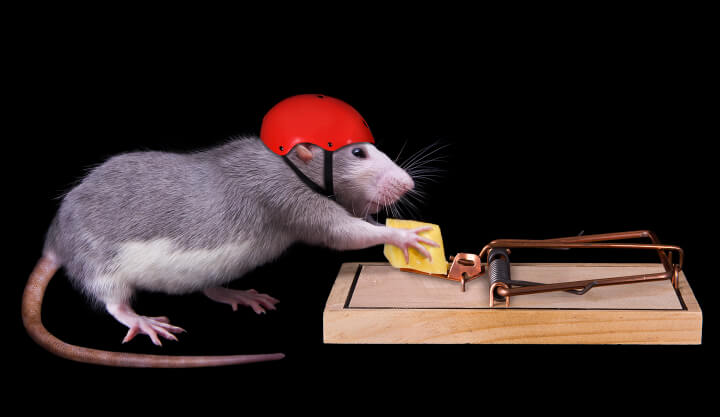


Whether we like it or not, rats and mice coexist with us, thrive as a result of us, and survive despite our efforts to destroy them. While they mean no harm, the presence of rodent populations can indeed cause us trouble at times. To 'control' them, a variety of solutions are available, including traps, ultrasonic pest repellents, and poisons. Many people deride these, however, as they feel that these cause harm to rodents.
So are there any humane mouse trap substitutes? Fortunately, yes. There are many homeowners who advocate the use of repellents. This could be because instead of killing or harming rodents, repellents simply cause mice to stay away from houses. Some humane mice repellents include scent repellents and ultrasonic repellents, among others.
Read More: How Far Should You Space Mouse Traps Apart?
Mice repellents are good alternatives if you don’t want the hassle of dealing with a mouse trap and live (or sometimes dead) rodents. But according to experts, repellers don’t typically work. Although these repellers may appear to be simple ways to control mice, especially in the short term, there is no conclusive evidence that they function in the long run.
Mice require only a small amount of food (approximately 3g per day) and nesting material to make themselves at home. They won’t leave once they have discovered a safe, warm spot away from predators, as they prefer to put up with any repellents you may have placed.
If we’re talking about keeping mice away from homes, exclusion is the most effective mouse repellent. If you can prevent mice from entering your home in the first place, you won't need to resort to mice repellents.
Keeping your home clean both inside and out will help keep mice at bay. They’re drawn to places where they can hide and eat, so getting rid of those things is a smart starting step. Keep your grass and other landscaping groomed in your yard. Leave no food or garbage outside. If you have bird feeders, make sure the ground surrounding them is free of seeds. Keep clutter to a minimum on the inside. Wipe up any spilt food on the floor. Store pantry items in plastic containers, such as cereal or grains.
If you choose to use a repellent, it's good to note that there are two types of repellents: scent and ultrasonic. In general, both are non-toxic and poison-free, making them both safe for households with small children.
Generally, scent repellents rely purely on a rodent's sense of smell to repel them, while ultrasonic pest repellents repel mice and rats using high-frequency noise.
Mice typically have sensitive noses. This is what attracts them to food found in houses. Scent repellents take advantage of this high sensitivity to repel mice by using strong smells. These repellents deter rodents from congregating in or around houses because they’re thought to offend their sense of smell or cause respiratory and general discomfort. Some repellents may also act as irritants if the animal gets some on its body.
Peppermint is a popular scent used, given its strong but pleasant scent. But some homeowners swear by cayenne, pepper, and cloves as well. Homeowners would typically soak these scents in cotton balls and leave them in areas where mice might enter the home. There are also ready-made sprays with special formulations that also cause strong odors that will repel mice.
Apart from having sensitive noses, mice also have sensitive hearing. Like many animals, they are able to hear sound at wavelengths we humans are unable to. Ultrasonic repellents use this to produce an irritating ultrasonic sound that is theoretically only audible to mice, thereby deterring them from approaching.
Typically, these devices are connected to a power source by an electrical socket. On the other hand, some are battery-operated, making them more convenient to use in fields, gardens, sheds, and other locations where power is not available.
It is because of their ease of use and the fact that they are silent to human hearing that Ultrasonic gadgets have gained popularity and appeal among consumers mostly because they’re fairly easy to use and are silent to human hearing. Electromagnetic and subsonic devices are also available, and each design differs in terms of signal intensity, pace, and frequency, among other characteristics.
Despite these, there has been no solid proof that repellents, scent or ultrasonic, are particularly effective at keeping rodents away. Mice are fairly smart and adaptable creatures and will learn to get used to the smell or noise produced by repellents. This makes repellents fairly effective in the short term, but the longer you rely on them, the less effective they become.
Ultimately, keeping a tidy home and making sure that all possible entry points are sealed are still the best way to actually repel mice from where you live.
Learn More: Do Ultrasonic Mouse Repellents Hurt Dog Ears?

Obviously keeping a clean and tidy home can prevent any rodent infestation. But sometimes, that isn’t enough to keep them at bay. That’s why mice control solutions like repellents and traps remain popular.
One of the more popular solutions to mice control is using mouse traps. There are a variety of different traps available in the market, such as snap, traps, glue traps, kill traps, and live-catch traps. They all work on the principle of capturing - or sometimes, killing - mice. These traps typically use baits such as peanut butter to lure mice. Mouse traps, regardless of type, are thought to be particularly effective at capturing and exterminating individual rodents. It should be emphasized, however, that mouse populations expand quickly and frequently necessitate more drastic pest management procedures. These traps are relatively cheap and reusable, meaning that they are a cost-effective solution to your rodent infestation problem.
However, some traps, particularly snap traps, are tricky to set up as the triggers could be sensitive and get set off prematurely. You may also have to use quite a number of them, especially if there is a large infestation in your home. Additionally, since these traps capture (or sometimes kill) mice, you will inevitably have to release or dispose of the rodents, which could be an additional hassle for you.
The biggest allure of mice repellents is the perception that they’re a more humane option for keeping those pesky pests away. Also, deterring mice from coming to your home instead of killing them may actually encourage more of the rodents from coming in. This is because when mice are killed, more will typically move in to take over the available resources.
Despite this, some repellents can also be made with household items such as mothballs or spices, such as cayenne pepper or cloves. This also makes them a cost-effective solution. Ultrasonic repellents can also come cheap, with packs of 6 typically coming in between $15-$40. However, you may need to place many of them around your home to ensure maximum effectiveness, and this could drive costs up.
Another drawback to using repellents is that they don’t get rid of mice that are already existing inside your home. As mentioned, once mice make a nest in your home, they’re unlikely to leave despite your efforts in using repellents. In such cases, you might have to think about using traps. Unfortunately, there’s no such thing as a humane mouse trap.
| Pros | Cons | |
| Mouse Traps | More effective in controlling mice infestationCost-effective | Tricky to set upMany traps are typically neededWould need extra work to get rid of the rodents |
| Mouse Repellents | HumaneHomemade options are cost-effective | Doesn’t solve the problem of existing mice infestationMay cause more mice to infest your home in the long termUltrasonic options could be pricey |
Knowing that mice repellents aren’t generally effective, particularly in the long run, we’ve already mentioned that exclusion is the best way to keep mice at bay. In light of a lack of a humane mouse trap option or actually effective repellents, here are some tips to exclude mice from your home.
To keep mice and rats away from your home, the most critical preventive precaution you can take is to thoroughly inspect the foundation and walls of your home to ensure that any potential access sites have been sealed off. Fall is a particularly opportune time to do your inspection tour since rats are trying to get in from the cold, which is why they are seeking shelter. In order to prevent mice from entering via cracks as small as 1/4 inch in diameter, masonry repair material should be used to seal foundation fractures, and joints around windows and door sills should be checked for fissures that could allow rats to enter.
Check to see that the weather seals along the bottom edges of garage doors are in good working condition. Your garage may become a welcoming home for a rat especially if it’s properly insulated. Check your attic as well, because rodents are attracted to the warmth provided by insulation. There is currently no entirely effective rodent-proof insulation available on the market, but spray foam insulation may be beneficial in keeping mice away.
Mice only require modest amounts of food on a daily basis. Remove the foods that they enjoy eating from your home in order to get rid of them. Store all grains, pet food, and other dry items in glass or metal containers, which are more secure than plastic containers since rodents cannot chew through glass or metal containers.
For the best chance of keeping mice away from your home, store any potential food sources in tamper-proof bins, avoid leaving pet food out for extended periods of time, and clean up spills and other messes immediately.
Casual, sloppy housekeeping that leaves spilt crumbs or food scraps on floors or countertops serves as an invitation for mice and rats to infiltrate the home. Always keep a broom nearby to collect crumbs, and never leave uneaten bowls of pet food in dishes on the floor to collect dust. If you have a pet bird, make sure to pick up any seeds that have dropped on the floor beneath the cage.

Don’t wait until your pest problems worsen and infest your entire home. If your mouse traps and mouse trap substitutes aren’t working, then it’s time to seek the help of the experts at Permakill Exterminating.
Permakill Exterminating not only provides pest control for mice, but also for other insects and pests like bed bugs, spiders, termites, and squirrels. Our team is committed to providing you with outstanding pest management services, leaving you with a tranquil, secure, and pest-free environment. Call Permakill Exterminating today.